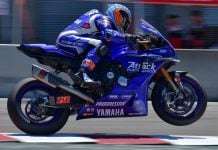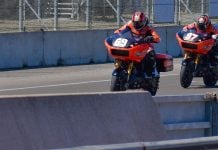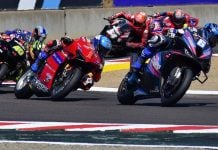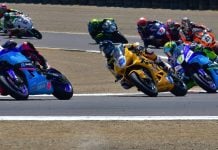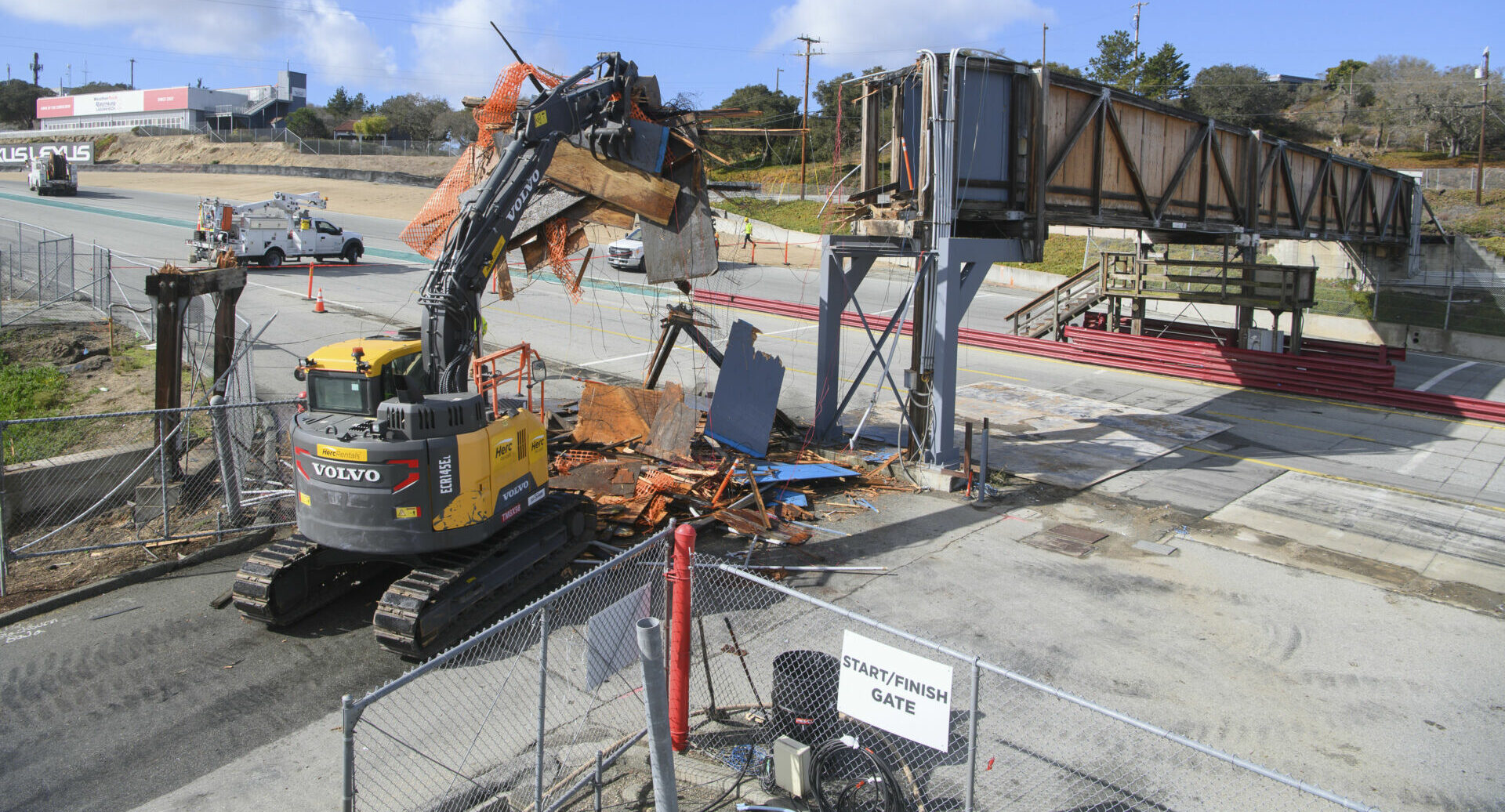Green Flag Waved 65 Years Ago Today to Open Monterey County’s Newest Attraction: Laguna Seca
Major General William M. Breckinridge being assisted by SCRAMP President Lou Gold during the ribbon cutting.
MONTEREY, Calif., November 9, 2022—Perhaps few knew on that Saturday morning, November 9, 1957, who were attending the 8th Annual Pebble Beach National Championship Sports Car Road Races on a hastily-built road course carved into the Fort Ord Army Installation, that it was the beginning of an enduring and iconic motorsports venue. Sixty-five years ago today, the ribbon was cut, and America’s newest road course opened in scenic Monterey, Calif.
The 8th Annual event was a first for Laguna Seca, as the name was a carryover of the races that began in 1950 racing through the Del Monte Forest of Pebble Beach, which had also added a Concours d’Elegance to bring a social atmosphere to its race weekend. Six years later in 1956, the Pebble Beach Road Races showed the imperative need for a safer, larger race track to host what had become one of the most famous competitions in North America. Following Ernie McAfee’s death during a crash that year, it was decided that the current Pebble Beach course was “not enough track” to house the rising horsepower that was being created annually.
The race, however, had become a mainstay–and a financial boon–in the Monterey region. To keep the race momentum going, during an August 1956 meeting of the Monterey Special Events Committee, it was suggested that a permanent committee be formed to explore keeping the Pebble Beach races on the Peninsula. That committee later became the non-profit Sports Car Racing Association of the Monterey Peninsula (SCRAMP). Their vision and perseverance led to establishing a race circuit that would become known worldwide.
Many obstacles were ahead for the newly formed group. Once the site was selected with advisement of the Sports Car Club of America, negotiations began with Major General Gilman Mudgett, then Fort Ord commander for the use of the site. Once received, it went up the chain of command to the Sixth Army in San Francisco, which approved. The Defense Department, however, in January 1956 withheld its permission on the grounds that a military reservation was not suitable for an event of this kind because of liability and public opinion.
After several months of lobbying by Fort Ord and Sixth Army officials, as well as California Congressional members, the Defense Department reversed its opinion and left it up to the Fort Ord Commander. Mudgett gave his permission with the stipulation that a property lease be drawn up between the military and Monterey Peninsula Chamber of Commerce, which then admitted the newly formed SCRAMP as a member to oversee the race.
A lease was signed between the U.S. Army and the Monterey Chamber of Commerce on Fort Ord property on Aug. 7, 1957. However, another hitch immediately developed. There were two lessees who retained cattle grazing rights from the Army on a portion of the property. Two separate leases were required, which took another three weeks’ time.
Once all the property rights were retained, it was now September when plans could be finalized for a November 9 race weekend. Incredibly, the 9-turn road course was created in just 60 days at a cost of $125,000, just in time for its inaugural race on Nov. 9 and 10, 1957.
Wallace Holm, a young Salinas architect, was site development chair and explained the track design by literally drawing a rough diagram in the dirt, then staked the course and the bulldozers went to work.
One of the most famous, one-of-a-kind turns in all of motorsports–the Corkscrew–sits atop the circuit like a crown. As the story goes, the construction foreman drove up the hill and informed the bulldozer driver he was going to lunch. When asked what the plan was for the next phase of the track, the foreman said just get down the hill any way you can. Thus, the hard-left, hard-right combination known throughout motorsports was created.
The first race program included some cautionary advice for visitors, such as: “Stay away from the hay bales. They were put there because experts felt that was where a car going wild would hit. Don’t try to prove the experts wrong the hard way,” and “Don’t try to cross the track. At least, you are exposing yourself to arrest. And you may be tempting a quick and painful and final end to your day’s spectating.”
Sixty-five years later, the “dry lagoon” has been the venue for countless memorable moments. As a non-motorsports entertainment site, Laguna Seca has hosted such dignitaries as The Pope, Beach Boys and Grateful Dead. Its reputation in motorsports is legendary. The Who’s Who of racing like Dan Gurney, Sir Stirling Moss, Phil Hill, Jim Clark, Mario Andretti, Bruce McLaren, Bobby Rahal, Roger Penske, Valentino Rossi, and Wayne Rainey are among the countless Hall of Fame athletes who have raced on the iconic circuit. Even actor/racer Paul Newman favored the Monterey location by constructing garages for his race team. The Newman Building remains in use today.
“Laguna Seca’s place in history is in line with Monza, Nurburgring, Silverstone and other iconic race tracks in the world,” comments Wayne Rainey, three-time 500cc World Champion and president of MotoAmerica. “I’ve travelled all over the world racing and motorsport enthusiasts everywhere know Laguna Seca and the Corkscrew. Laguna Seca is a place where all the greats have raced and for me it sits at the top of the list. I won National Championship events at Laguna and my three Grand Prix victories there played an important role in winning my World Championships. Now, with MotoAmerica, we’re continuing to work closely with the race track so our riders, teams, and fans can continue to enjoy the facility and the race track as part of our championship.”
As the decades-old Start/Finish bridge comes down to be replaced by a new pedestrian and cart bridge, and then followed by track repaving, the County of Monterey-owned Laguna Seca Recreation Area still thrives. The park remains open daily for campers, recreationalists, and special events during the construction phase.
“WeatherTech Raceway Laguna Seca truly is a jewel in the crown of the many amazing amenities offered on our beautiful Monterey Peninsula,” commented County of Monterey Board of Supervisors Chair Mary L. Adams. “Like many local residents, I have enjoyed the thrill of championship racing as well as other entertainment provided at Laguna Seca throughout the years. The span of seeing both the Pope and the Grateful Dead sort of explains it all. We are proud of the improvements we are making at the track and know visitors will be delighted. We always welcome people to our area and love sharing the rich heritage of Laguna Seca with them. Come enjoy some time in Monterey County. You’ll always want to return.”
For information on camping, special events and an update on the capital improvements, visit WeatherTechRaceway.com or call the Tickets and Accommodations Specialists at 831-242-8200.


